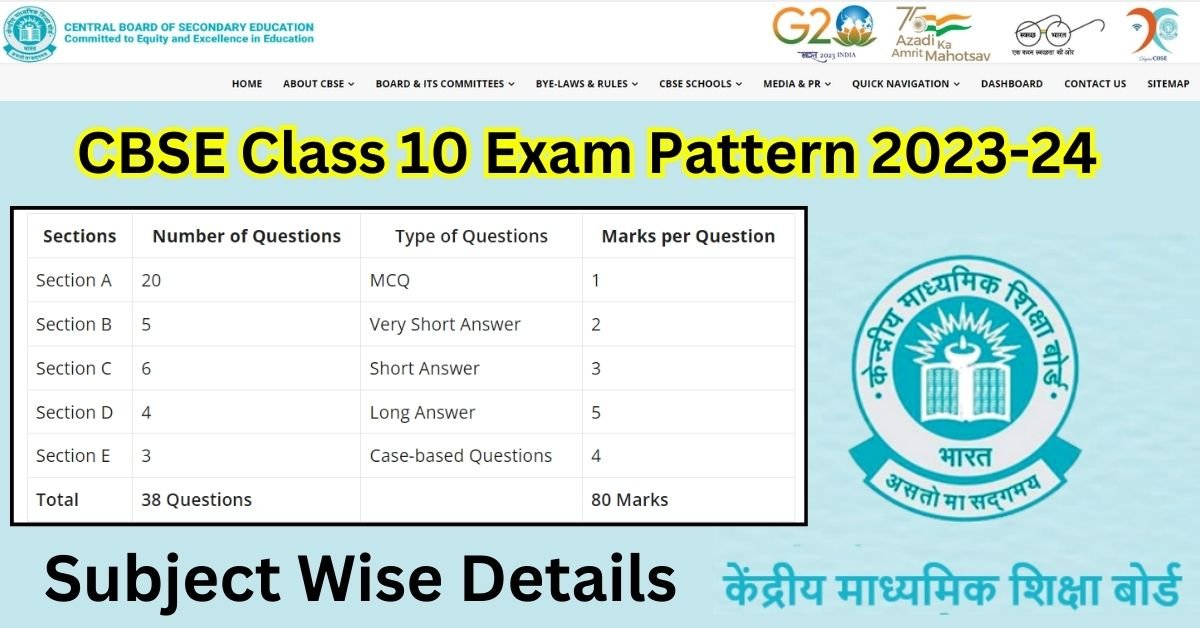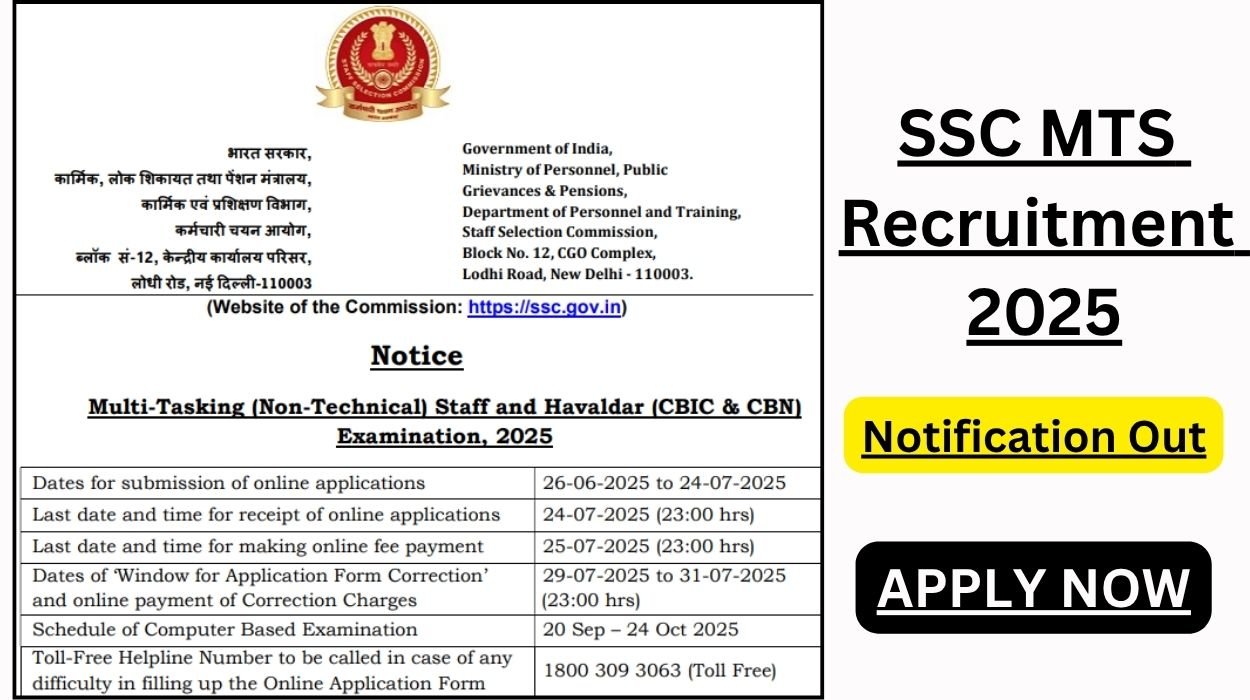CBSE Class 10 Exam Pattern 2023-24 – Some changes have been made in the CBSE exam pattern. Changes have been made in the Class 10 exam to be held in 2024. You will be given complete information about the new exam pattern released by CBSE on this post.
As per the announcement made on 6th April 2022, students can expect multiple choice questions in the upcoming board exams. Details about CBSE 10th Pattern for 2024 are available on the official website. You can also check the exam pattern from there.
| Topics | Information |
|---|---|
| Exam Conducting Body | Central Board of Secondary Education |
| Exam Mode | Offline |
| Exam Duration | 3 Hours |
| Medium of Exam | English / Hindi |
| Subjects | 5 or 6 (including optional) |
| Subjects Name | Language 1, Language 2, Mathematics, Science, Social Science, 6th Additional Subject |
| Type of Questions | Competency-based questions, MCQs, short and long answer type questions |
| Total Marks for a Subject | 100 |
| Theory Marks | 80 |
| Internal Assessment | 20 |
| Negative Marking | No |
| Passing Marks | 33% in each subject and in aggregate |
Important information for all the CBSE board students who are preparing for class 10th exam. First of all, it is very important to understand the exam pattern and after that it is very important to have complete information about the syllabus, only after this you can do your preparation properly. Every time changes are made in the exam pattern and syllabus.
CBSE Class 10 Date Sheet 2024 Download PDF Link
CBSE Class 10 Exam Pattern 2023-24
CBSE Class 10 exam pattern information is given below
| Question | Answer |
|---|---|
| Exam Mode | Offline (pen and paper) |
| Subjects Included | Language 1, Language 2, Mathematics, Science, Social Science, 6th Additional Subject |
| Duration | 2 hours |
| Total Marks | 100 (80 for theory, 20 for internal assessment) |
| Question Types | Multiple choice, competency-based, long/short answer |
| Negative Marking | NO |
Question Types and Weightage for Board Exam 2024
| Type of Questions | Weightage |
|---|---|
| Multiple Choice | 40% |
| Competency-Based | 20% |
| Long/Short Questions | 40% |
CBSE Class 10 Subject-Wise Exam Pattern 2023-24
Mathematics
| Sections | Number of Questions | Type of Questions | Marks per Question |
|---|---|---|---|
| Section A | 20 | MCQ | 1 |
| Section B | 5 | Very Short Answer | 2 |
| Section C | 6 | Short Answer | 3 |
| Section D | 4 | Long Answer | 5 |
| Section E | 3 | Case-based Questions | 4 |
| Total | 38 Questions | 80 Marks |
Official Website – Click Here
Science
| Sections | Number of Questions | Type of Questions | Marks per Question |
|---|---|---|---|
| Section – A | 20 | MCQ | 1 |
| Section – B | 6 | Very Short Answer | 2 |
| Section – C | 7 | Short Answer | 3 |
| Section – D | 3 | Long Answer | 5 |
| Section – E | 3 | Source-Based/Case-Based | 4 |
| Total | 39 Questions | 80 Marks |
English (Language and Literature)
| Sections | Section Type | Total Marks |
|---|---|---|
| Section – A | Reading | 20 |
| Section – B | Writing and Grammer | 30 |
| Section – C | Literature | 30 |
| Total | 80 Marks | |
Social Science
| Sections | Number of Questions | Type of Questions | Marks per question |
|---|---|---|---|
| Section – A | 20 | MCQ | 1 |
| Section – B | 4 | Very Short Answer | 2 |
| Section – C | 5 | Short Answer | 3 |
| Section – D | 4 | Long Answer | 5 |
| Section – E | 3 | Case Study Based | 4 |
| Section – F | 1 | Map | 5 |
| Total | 37 Questions | 80 Marks |
CBSE Class 10 Grading System 2023-24
| Grade | Awarded To | Marks Range |
|---|---|---|
| A1 | Top 1/8th of the passed candidates | 91 – 100 |
| A2 | Next 1/8th of the passed candidates | 81 – 90 |
| B1 | Next 1/8th of the passed candidates | 71 – 80 |
| B2 | Next 1/8th of the passed candidates | 61 – 70 |
| C1 | Next 1/8th of the passed candidates | 51 – 60 |
| C2 | Next 1/8th of the passed candidates | 41 – 50 |
| D1 | Next 1/8th of the passed candidates | 31 – 40 |
| D2 | Next 1/8th of the passed candidates | 21 – 30 |
| E* | Essential Repeat | 0 – 20 |
Exam Pattern 2023-24 – Topic-wise Weightage
Information about how many questions will be asked on the basis of topic is given here. There are different topics in each subject and questions are asked from those topics, information about which is given to you here. You have to make your preparations based on this only.
Mathematics
| Unit | Topic | Marks Weightage |
|---|---|---|
| I. | Number System | 06 |
| II. | Algebra | 20 |
| III. | Coordinate Geometry | 06 |
| IV. | Geometry | 15 |
| V. | Trigonometry | 12 |
| VI. | Mensuration | 10 |
| VII. | Statistics and Probability | 11 |
| Total Theory Marks | 80 | |
| Internal Assessment | 20 | |
| Total Marks | 100 | |
Science
| Unit | Topic | Marks Weightage |
|---|---|---|
| I. | Chemical Substances – Nature and Behaviour | 25 |
| II. | World of Living | 25 |
| III. | Natural Phenomena | 12 |
| IV. | Effects of Current | 13 |
| V. | Natural Resources | 05 |
| Total Theory Marks | 80 | |
| Internal Assessment | 20 | |
| Total Marks | 100 | |
English (Language and Literature)
| Section | Topic | Marks weightage |
|---|---|---|
| I. | Reading Skills | 20 |
| II. | Writing Skills and Grammar | 20 |
| III. | Literature | 40 |
| Total Theory Marks | 80 | |
| Internal Assessment | 20 | |
| Total Marks | 100 | |
Social Science
| Unit | Topic | Marks weightage |
|---|---|---|
| I. | History – India and Contemporary World II | 20 |
| II. | Geography – Contemporary India II | 20 |
| III. | Political Science – Democratic Politics II | 20 |
| IV. | Economics – Understanding Economic Development | 20 |
| Total Theory Marks | 80 | |
| Internal Assessment (Map-based Project) | 20 | |
| Total Marks | 100 | |
CBSE Class 10 Maths Syllabus 2023-24
Information about the questions asked in Maths subjects is given below. You have to study on the basis of topic only. Complete information about the syllabus is given below. Check it.
| Chapter | Deleted Topics |
|---|---|
| Real Numbers | Euclid’s Division Lemma, decimal representation of rational numbers in terms of terminating/non-terminating recurring decimals |
| Polynomials | Statement and simple problems on division algorithm for polynomials with real coefficients |
| Pair of Linear Equations in Two Variables | Simple problems on equations reducible to linear equations |
| Coordinate Geometry | Area of a Triangle |
| Triangles | Proof of the Theorems: 1. If a perpendicular is drawn from the vertex of the right angle of a right triangle to the hypotenuse, the triangles on each side of the perpendicular are similar to the whole triangle and to each other. 2. The ratio of the areas of two similar triangles is equal to the ratio of the squares of their corresponding sides. 3. In a right triangle, the square on the hypotenuse is equal to the sum of the squares on the other two sides. 4. In a triangle, if the square on one side is equal to sum of the squares on the other two sides, the angles opposite to the first side is a right angle. |
| Constructions | Whole Chapter Deleted |
| Trigonometric Identities | Trigonometric ratios of complementary angles |
| Surface Areas and Volumes | Frustum of a cone, problems involving converting one type of metallic solid into another and other mixed problems (problems with combination of not more than two different solids) |
| Statistics | Step deviation method for finding the mean, cumulative frequency graph |
CBSE Class 10 English Syllabus 2023-24
Information about the questions asked in English subjects is given below. You have to study on the basis of topic only. Complete information about the syllabus is given below. Check it.
| Section | Deleted Topics |
|---|---|
| Grammar | Use of Passive Voice Clauses – Noun Clauses, Adverb Clauses, Relative Clauses Prepositions |
| First Flight | Prose: The Hundred Dresses – I The Hundred Dresses – II Poetry: Animals |
| Footprints without Feet | The Hack Driver |
CBSE Class 10 Social Science Syllabus 2023-24
History (India and the Contemporary World – II)
| Section | Chapter No. | Chapter Name |
|---|---|---|
| I – Events and Processes | I. | The Rise of Nationalism in Europe |
| II. | Nationalism in India | |
| II – Livelihoods, Economies, and Societies | III. | The Making of a Global World (Sub-topics – 1 to 1.3 Pre Modern World to Conquest, Disease and Trade) |
| Interdisciplinary project as a part of multiple assessments (Will be assessed internally – subtopics 2 to 4.4 The nineteenth century (1815-1914) to the end of Bretton Woods & the beginning of Globalisation) | ||
| IV. | The Age of Industrialization (Will be assessed only in periodic assessments) | |
| III – Everyday Life, Culture and Politics | V. | Print Culture and the Modern World |
Geography (Contemporary India – II)
| Chapter No. | Chapter Name |
|---|---|
| 1. | Resources and Development |
| 2. | Forest and Wildlife Resources |
| 3. | Water Resources |
| 4. | Agriculture |
| 5. | Minerals and Energy Resources |
| 6. | Manufacturing Industries |
| 7. | Lifelines of National Economy (only map) |
| Interdisciplinary project as a part of multiple assessments (internal assessment) |
Political Science (Democratic Politics – II)
| Unit No. | Chapter No. | Chapter Name |
|---|---|---|
| I. | 1. | Power Sharing |
| 2. | Federalism | |
| II. | 3. | Gender, Religion, and Caste |
| III. | 4. | Political Parties |
| IV. | 5. | Outcomes of Democracy |
Economics (Understanding Economic Development)
| Chapter No. | Chapter Name |
|---|---|
| 1. | Development |
| 2. | Sectors of the Indian Economy |
| 3. | Money and Credit |
| 4. | Globalization and The Indian Economy (What is Globalization?, Factors that enabled Globalization) |
| Interdisciplinary project as part of multiple assessments (Production across the countries, Chinese toys in India, World Trade Organization, the struggle for a fair Globalisation) | |
| 5. | Consumer Rights (Project Work) |
CBSE Class 10 Science Syllabus 2023-24
| Unit | Chapter | Topics |
|---|---|---|
| Chemical Substances – Nature and Behaviour | Chemical Reactions | Chemical equation, balanced chemical equation and its implications Types of chemical reactions: combination, decomposition, precipitation, displacement, double displacement, endothermic exothermic reactions, oxidation and reduction |
| Acids, Bases, and Salts | Their definitions in terms of furnishing of H+ and OH– ions, general properties, examples and uses, neutralization, concept of pH scale (definition relating to logarithm not required), importance of pH in everyday life Preparation and uses of Sodium Hydroxide, Bleaching Powder, Baking Soda, Washing Soda and Plaster of Paris | |
| Metals and Non-Metals | Properties of metals and non-metals, reactivity series, formation and properties of ionic compounds, basic metallurgical processes, corrosion and its prevention | |
| Carbon Compounds | Covalent bonding in carbon compounds, versatile nature of carbon, homologous series, nomenclature of carbon compounds containing functional groups (halogens, alcohol, ketones, aldehydes, alkanes and alkynes), difference between saturated hydro carbons and unsaturated hydrocarbons Chemical properties of carbon compounds (combustion, oxidation, addition and substitution reaction). Ethanol and Ethanoic acid (only properties and uses), soaps and detergents | |
| World of Living | Life Processes | ‘Living Being’, basic concept of nutrition, respiration, transport and excretion in plants and animals |
| Control and Co-ordination in Animals and Plants | Tropic movements in plants, introduction of plant hormones Control and co-ordination in animals: nervous system, voluntary, involuntary and reflex action, chemical co-ordination, animal hormones | |
| Reproduction | Reproduction in animals and plants (asexual and sexual), reproductive health – need and methods of family planning, safe sex vs HIV/AIDS, child bearing and women’s health | |
| Heredity and Evolution | Heredity, Mendel’s contribution – laws for inheritance of traits, sex determination – brief introduction (topics excluded – evolution; evolution and classification and evolution should not be equated with progress) | |
| Natural Phenomenon | Light – Reflection and Refraction | Reflection of light by curved surfaces, images formed by spherical mirrors, centre of curvature, principal axis, principal focus, focal length, mirror formula (derivation not required), magnification Refraction, laws of refraction, refractive index, refraction of light by spherical lens, image formed by spherical lenses, lens formula (derivation not required), magnification, power of a lens |
| Human Eye and the Colourful World | Functioning of a lens in human eye, defects of vision and their corrections, applications of spherical mirrors and lenses, refraction of light through a prism, dispersion of light, scattering of light, applications in dailylife (excluding colour of the sun at sunrise and sunset) | |
| Effects of Current | Electricity | Electric current, potential difference and electric current, Ohm’s law, resistance, resistivity, factors on which the resistance of a conductor depends, series combination of resistors, parallel combination of resistors and its applications in daily life Heating effect of electric current and its applications in daily life, electric power, interrelation between P, V, I and R. |
| Magnetic Effects of Current | Magnetic field, field lines, field due to a current carryingconductor, field due to current carrying coil or solenoid, force on current carrying conductor, Fleming’s Left Hand Rule, direct current Alternating current, frequency of AC, advantage of AC over DC, domestic electric circuits | |
| Natural Resources | Our Environment | Eco-system, environmental problems, ozone depletion, waste production and their solutions, biodegradable and non-biodegradable substances |
CBSE Class 10 Exam Pattern 2024
The CBSE Class 10 Board Exam for the 2023-24 session are set to take place from February 15th, 2024, to March 13th, 2024.




